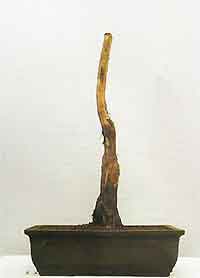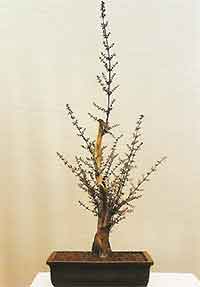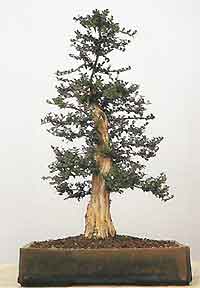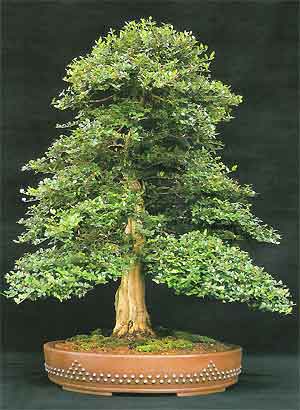Bonsai Trees
Case Histories
Lonicera Nitida - (dwarf honeysuckle)
Lonicera Bonsai Style: Informal Upright

This lonicera 'nitida' was found in late winter, growing on some wasteland which had recently become a building site. I can only think that many years before, somebody had dumped lots of hedge clippings there and as honeysuckle is easy to root, many had. There was a small gathering of at least fifty vines, most of which were over 1 3/4 metres (6 feet) tall.
I managed to crawl amongst them and spotted one that instantly appeared to stand out from the rest. The tree was easy to remove and had a good root system. It was heavily pruned and the many fibrous roots allowed it to be potted straight into a deep bonsai pot. The lonicera was then left to recover in a sheltered area of the garden.

It was not long before the tree began to show signs of life and several buds appeared. Normally I allow all collected trees at least one year to establish, often two or more before I start training them. However, by early summer this lonicera was growing so strongly that I decided to proceed with some basic styling.
Lonicera Bonsai History: Training
As I began structuring the many long shoots I soon noticed that there was a large gap in the top right-hand side of the trunk, where no buds had developed. This presented a problem and I considered ways of masking this area. I decided to prune back all branches hard, feed heavily and leave the tree at an angle where this area would be facing the most direct sunlight. Four weeks later a shoot appeared in exactly the place where one was needed. How fortunate!

The tree was left to grow unchecked for the rest of the year, helping to thicken the branches. It was repotted the following spring and the roots were found to be in excellent condition. The soil level was slightly lowered to improve the flair of the buttress and expose the surface roots.
During the year I kept the branches lightly trimmed, but allowed the leader to grow freely. This needed to thicken considerably to hide the 'chop' where the trunk had been reduced in height.
I peeled off some of the bark to reveal a fresh, smooth trunk underneath. Lonicera has flaky bark and is one of the few trees where loose bark can be peeled off without causing the tree any harm at all.
Only just over a year on and the tree was already beginning to look like it had been in training for much longer. The foliage pads were developing nicely and I completely wired every branch and twig on the tree. I spent much time working on the apex as I think that this is one of the most significant parts of the tree, since a well structured crown really finishes off the whole appearance.

In the spring I wanted to repot the lonicera and change the pot. I heavily root pruned the tree and laid out a selection of possible pots, trying the tree in each one. Some were slightly better, but none were what I'd really been looking for.
I began to search my bonsai shed to check for any other spare pots and found a pot that I had bought several years ago from a friend, not for a particular tree but simply because I liked it. Being shallower, it was a good match and the lonicera remained in this pot for the next three years, being repotted every year as it is such a vigorous grower.
Three years later and the lonicera had become a fine tree, always being very green and healthy. It had outgrown the current pot and it was certainly time for a change. I decided that it would look good in a recently purchased drum pot. It was not as deep as the pot it was replacing and the studs made it look even shallower. Being round it appeared smaller and so the overall effect was nothing short of a transformation.
 This lonicera 'nitida' was found in late winter, growing on some wasteland which had recently become a building site. I can only think that many years before, somebody had dumped lots of hedge clippings there and as honeysuckle is easy to root, many had. There was a small gathering of at least fifty vines, most of which were over 1 3/4 metres (6 feet) tall.
This lonicera 'nitida' was found in late winter, growing on some wasteland which had recently become a building site. I can only think that many years before, somebody had dumped lots of hedge clippings there and as honeysuckle is easy to root, many had. There was a small gathering of at least fifty vines, most of which were over 1 3/4 metres (6 feet) tall. It was not long before the tree began to show signs of life and several buds appeared. Normally I allow all collected trees at least one year to establish, often two or more before I start training them. However, by early summer this lonicera was growing so strongly that I decided to proceed with some basic styling.
It was not long before the tree began to show signs of life and several buds appeared. Normally I allow all collected trees at least one year to establish, often two or more before I start training them. However, by early summer this lonicera was growing so strongly that I decided to proceed with some basic styling. The tree was left to grow unchecked for the rest of the year, helping to thicken the branches. It was repotted the following spring and the roots were found to be in excellent condition. The soil level was slightly lowered to improve the flair of the buttress and expose the surface roots.
The tree was left to grow unchecked for the rest of the year, helping to thicken the branches. It was repotted the following spring and the roots were found to be in excellent condition. The soil level was slightly lowered to improve the flair of the buttress and expose the surface roots. In the spring I wanted to repot the lonicera and change the pot. I heavily root pruned the tree and laid out a selection of possible pots, trying the tree in each one. Some were slightly better, but none were what I'd really been looking for.
In the spring I wanted to repot the lonicera and change the pot. I heavily root pruned the tree and laid out a selection of possible pots, trying the tree in each one. Some were slightly better, but none were what I'd really been looking for.